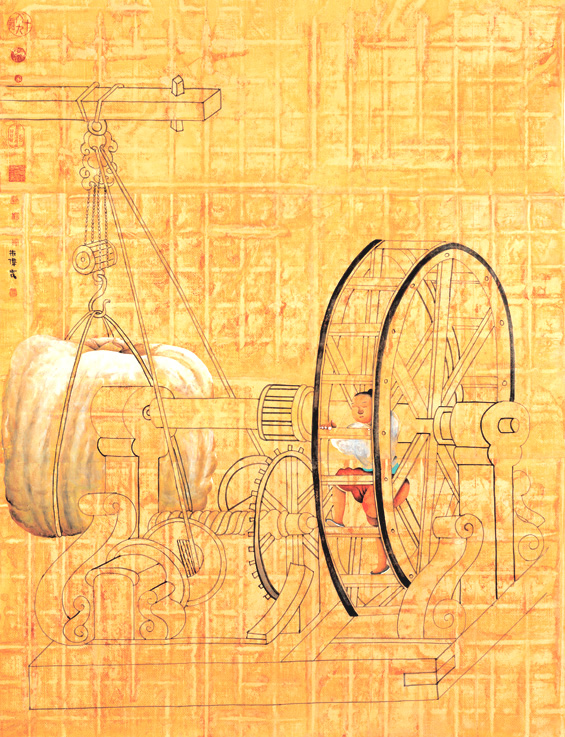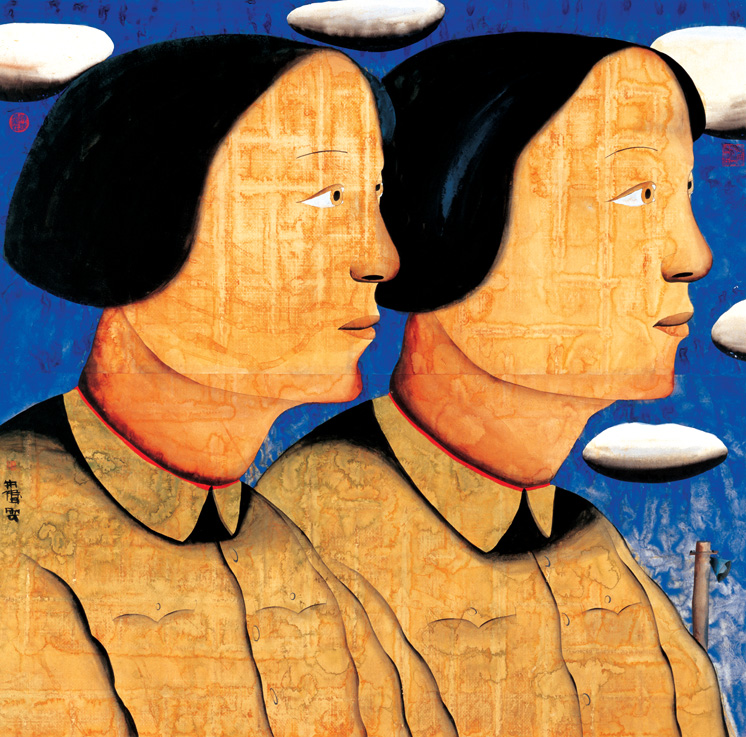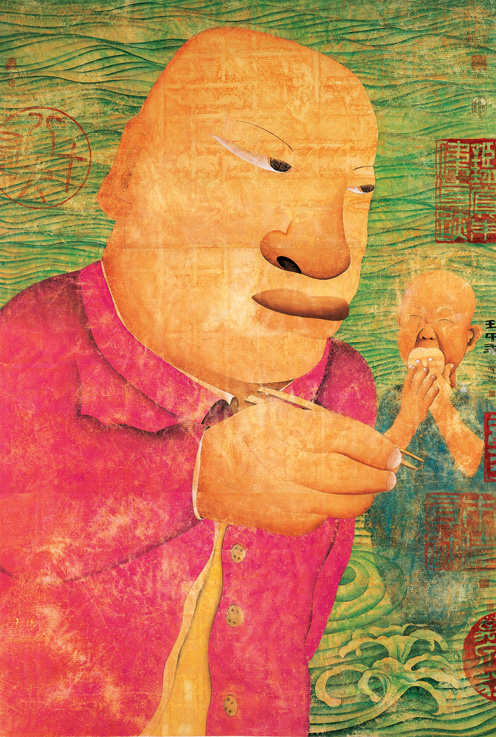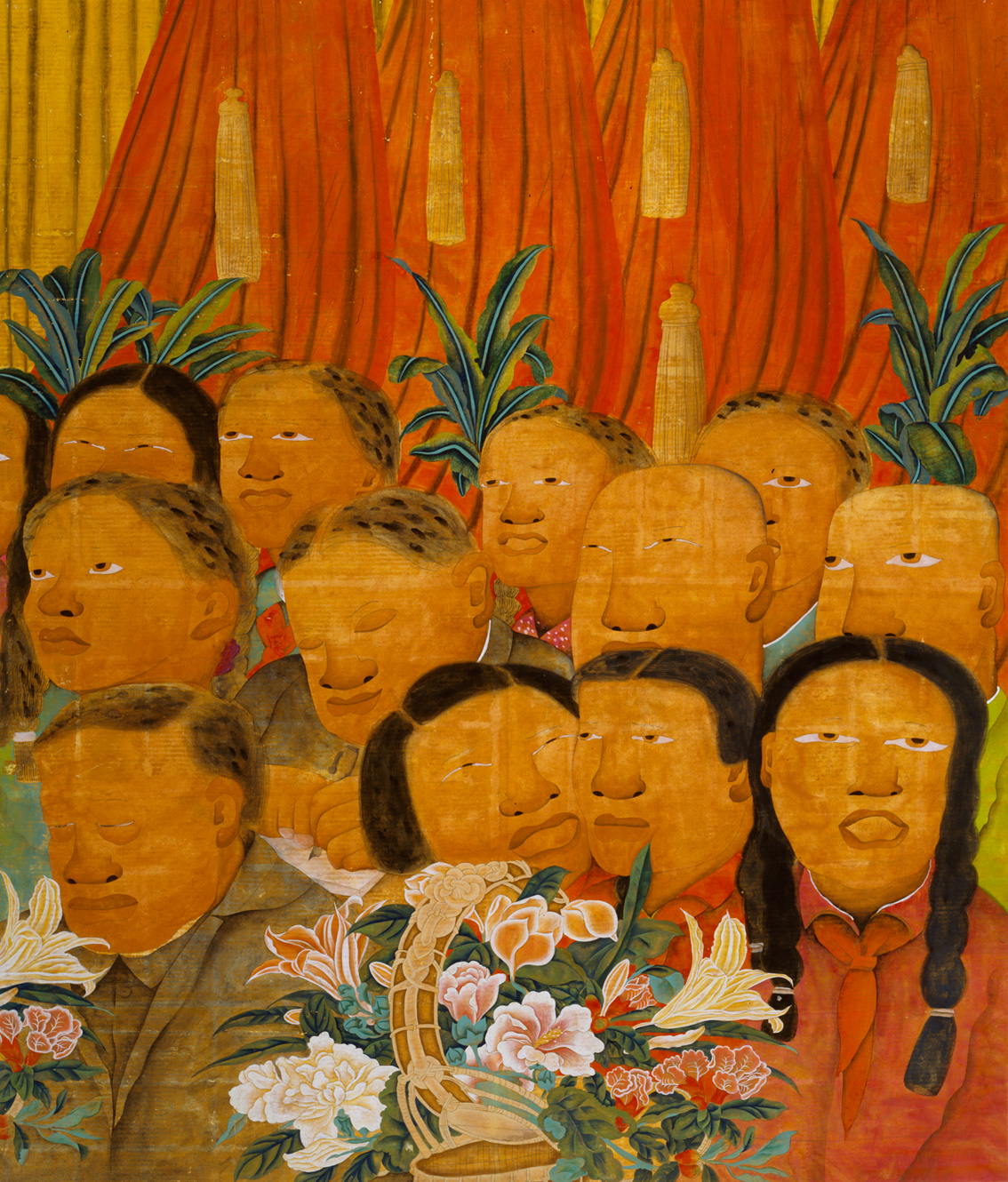
|
|
Chinese
Painting Techniques in the 20th Century
--Examples
of Zhu Wei’s Art Works in the 1990s
Looking at Zhu Wei’s paintings, the viewer often experiences a
sensation of gazing into a distant landscape. The scene may be a cloud
drifting slowly above a volcanic mountaintop, or the restlessness before
a rainstorm, or the calm felt thereafter. A physical landscape pay
rekindle memories, or evoke hope and aspirations. Zhu Wei’s painting
however, contain a sense of bitterness, as though that far away, dim
landscape is a destiny that possesses forces of both destruction and
rebirth. At that moment, all is silent.
Zhu Wei’s paintings are simple and solemn in nature. They retain the
strength and vitality of historical elements and are laden with the
icons of our times. A theme of genesis that is often found in Zhu
Wei’s paintings, allows him to avoid the influence of fads, trends and
other such disturbances. He employs true emotions and a balanced outlook
to create an attitude, a judgment, or a circumstance, similar to the
undetected rumblings of subterranean lava, or the transformation of
clouds when the wind blows.
The nature world is a metaphor for reality. In nature, one species is
dependent on another for subsistence. We live in an enormous and
complicated ecosystem where species compete with one another for
survival. In such a environment, the rise and fall of each community is
left to fate. Humans remain at a primary level in the fight for
survival, and compared to other species, have a great amount of
undeveloped potential. Although humans possess far superior survival
tactics and have the ability to cooperate together to seek improvement,
we are nonetheless a long way from building a completely independent and
cohesive system.
Society mourns the demise of a great Chinese civilization, and must also
remember the suffering and uncertain fate of individual lives. China
today is infested with numerous and varied problems and vices. There are
no clear distinctions between each different system. Our communities are
at odds with one another. The users of group resources are unable to
secure a stable standard of living, hence their lives are a gamble.
Repeated upheaval indicates the difficulty to accumulate resources, and
results in a confused state of living.
|
|
Both the good and the bad live by basic instinct. We rely on certain
precedents to guide our actions, but we are unable to create rules and
regulations containing universal significant. A desire to see quick
results makes people selfish. Presently, China is in a state of flux,
with no clear defined sense of order in sight. The changes in China over
the last half of the 20th century are not only fundamental shifts, they
represent a turbulent period in a long and difficult passage through
history. Seeds of change planted in such a bizarre and frustrating era
will no doubt eventually exert their influence in the future.
|

|
|
Painters born in the 1960s have had to deal with such experiences. Many
of them feel isolated and lonely, surrounded by atrocities. They have
grown up in the company of human frailty and irrationally. Losses of
paternal authorities, barren souls, lack of the spiritual, and ever
growing materialism have contributed to a rite of youth that is
unthinkable elsewhere. When mature enough to think independently, these
youth began to question their world and they discovered absurdities,
prejudices, greed, and compromise in both individuals and society. They
have since found a sharp, penetrating voice to chronicle this empty
period of history.
Whatever the circumstance, humans seek warmth and encouragement. The
pioneers of knowledge toiled to spread life’s wisdom to the masses.
Fine art was created by this wisdom. And aesthetic experience is a
comfort to the human soul. Contemporary art in late 20th century China
is a self-conscious participation in the nurture and growth of a
societal culture, which in turn makes art an active component in social
change.
An important characteristic of Western contemporary art is its proximity
to life and reality. Rooted in an awareness of the self, its aim is the
exploration of a freer state of mind. It dismantles the burdens that
have been imposed on humans through politics, religion and science, and
explores the possibility of surpassing day-to-day existence. After
rebelling against traditional and conservative global views, Western
contemporary art adopted an open attitude towards elements found in all
known and unknown human territories. Modern art was created as a muti-faceted,
all-encompassing movement. It is direct and spontaneous. Through use of
techniques such as transfer, diversion and juxtaposition, it has broken
through the constraint of the visual arts. Frequent use of diverse
images, sounds, words and performances, explore various different ideas
and structures. Western modern art originally began as a revolt against
traditional culture in the late 19th century, and absorbed elements from
both the west and the east. Late 20th century art is a continuation of
this, with a pronounced characteristic of diversity. Modern art is the
leading light of trends and inclinations of the present era.
Contemporary Chinese art appropriated and borrowed the substance and
form of Western art for a period. It has since emerged as an important
force in a world that celebrates muti-culturalism and has finally found
a voice of its own.
Unfortunately, Chinese contemporary art also has its problems. In a
climate of preset ideologies, the critical attitude of modern art has
resulted in creations that are too cultured for the general public,
making it unable to reach the masses or produce effective in-depth
interaction with lower stratums of society. Art has been an exclusive
activity for the elite. The current challenge for China is to further
develop the pioneering spirit of art, and to promote its acceptance by
the whole society. Artists have begun to think consciously about a
solution to this dilemma. Since the early stage of his artistic life,
Zhu Wei has offered viable means for traditional Chinese art to blend
into its contemporary counterpart in order to achieve a new vitality.
|
|

|
Traditional Chinese art has a long history of magnificent achievements;
its influence is still strongly felt in society today. However, the loss
of a humanities-oriented environment and the passage of time have
hindered the inheritance and development of Chinese art in the later
part of the 20th century. Many attempts to change this situation have
come to naught. However, in the late 20th century, the substance and
form of traditional Chinese art, and the diversified characteristic of
Western art fused. The result has been a style reflective of the essence
of the times, and an effective way to rejuvenate Chinese art.
|
|
Zhu Wei’s paintings are a definitive example of this integration. His
identity as an artist, his use of traditional materials and techniques,
and the contents explored in his paintings, all demonstrate a distinct
Chinese spirit. This new form of art is clearly different from the past.
It has evolved from an interaction, or dialogue, with modern art’s
respect for muti-culturalism. The elements of China that are found in
Zhu Wei’s works derive directly from the content’s authenticity. The
traditional properties in his form and technique are traced to the
artist’s own identity, environment, character and personal preference.
By combining all of these elements, it is apparent that Zhu Wei’s
paintings exude a consistent and pure Chinese essence.
In the 1990s, Chinese art demonstrated a strong tendency to reflect life
and reality. Artists began to use their individual experiences and
thoughts, to speak out on the subject of the real world. Zhu Wei has
become notably significant among other Chinese contemporary artists
because he maintains the viewpoint of an ordinary Chinese citizen, and
fully utilises the techniques of traditional Chinese art to paint honest
pictures of Chinese life. His paintings do not evolve from obscure
ideas, nor do they pander to the curiosity of foreigners. Zhu Wei’s
art is about life itself, not artistic concepts, or sheltering oneself
from the outside world. Among his cohort of artists who link art with
reality, Zhu Wei is exceptional.
Once, when Zhu Wei spoke on topic of art, he mentioned the term
“exaggeration”. To him, art is a method of transferring the coldness
and hardness of reality into a visual image. It is also a way to express
concern for society, and to portray reality via analysis. Zhu Wei’s
paintings are a fine example of this technique. In his paintings, he
derives inspiration from society and reflects upon the imprints of time,
by highlighting the grim nature of the real world. He has a deep concern
of this world, and his paintings are the products of this compassion.
Zhu Wei is sensitive to reality. He is urged on by the life’s
imperfections to think and to explore further. He uses artistic means to
offer compassionate opinions about reality. Zhu Wei’s comprehensive
portrayals deeply move the viewer and offer a highly satisfying
aesthetic experience. To examine his paintings closely, one can feel the
intensity of his grasp on reality. He fully understands the truths of
human society and is not swayed by its ever-changing exterior. Zhu
Wei’s work exposes and attacks. It displays concern and empathy. The
depth and breadth of his work comes from a cultured mind, an ability to
see beneath the surface, and a depth of emotion. Colors, forms and
expressions are expertly used to convey his feelings. The viewer can
hear ‘sounds’ in the paintings by feeling the mood and movement of
the strokes and the colors. Zhu Wei intends his art to chronicle the
human nature of these times.
Zhu Wei attempts to build a link between reality and human mind. The
combination of a unique style, distinct forms, subtle yet meaningful
images, and a perfect blend of ink and wash, evokes strong feelings in
the viewer and elevates Zhu Wei’s painting to a spiritual level. His
paintings contain a textured quality and a balanced force. Zhu Wei also
aims to imitate colors and forms as close to reality as possible. This
is yet another reason why his paintings are widely appreciated and
accepted.
Zhu Wei juxtaposes classical and modern entities together in the same
frame. In some of his paintings, a contemporary object is found in a
traditional ‘flower-and-bird’ setting or in the midst of ancient
characters; people and settings from completely different eras appear
next to each other. Zhu Wei gives historical events a modern
interpretation. The combination is not simply for a humorous effect, but
to imply a deeper significant meaning set against the reality of our
present times. Sometimes, in order to intensify the feel of time of
track images and thoughts in progress, Zhu Wei creates a four-paneled
painting. Zhu Wei also creates sculptures inspired by bronze wares of
the Shang-Zhou era, and terracotta figurines of the Han dynasty, which
have a modern sense to them.
Zhu Wei is a contemporary artist, noted for his free use of many
different themes and forms. Perhaps one day he will adopt a new medium
to present his art. In this event, we may count on him to retain his
concern and criticism of humanity and society, combined with his courage
and passion for life, to concoct an artistic experience in true Chinese
essence.
Zhang
Li
July
2000, Beijing
First published in Zhu Wei Diary, p.14-19, published by Plum Blossoms (International) Ltd., 2000 |
|
|
|
Zhang Li has
been researching Chinese contemporary art since early nineties and has
built up his reputation in art circles as an important curator for
Chinese contemporary art. Now he is the main curator in Shanghai Gallery
of Art. |
|
二十世纪中国绘画方式
——朱伟在九十年代创作的例子
观看朱伟的作品,经常会产生一种面对深远的自然景色的感受,这一景色有时呈现为火山上空一朵缓缓移动的浮云,有时又会呈现为暴风雨前的不安或之后的宁静。观看风景时人们总是怀着希冀与回忆,而在朱伟的风景中却带着一丝苦涩,仿佛那幽远、微茫的景象和艰难漫长的路途担负着沉重的命运,虽然蕴含着来自于创世之初的毁减与再生的力量,却暂时归于沉寂。
朱伟作品中淡泊而凝重的品质是人们不由得产生这样的观感,这种品质保持了物质的初始状态的强度和活力,同时深刻地烙印着我们这一时代的沉重印记。对这种初始状态的把握使朱伟能够摒弃时尚和各种风雨阴晴的干扰,回归到原初的热力状态,以情感化和平实的外向气质构成态度、事理和意境,如同地下炽热的岩浆暗暗地运行、涌动于风云变幻的天空之下。
风景是对现实的隐喻。人类仍然没有脱离生存的自然状态。在自然界,生态系统中一种生物群体以另外的生物群体作为它们生存的资源,以维护自身的生存观念。如果将人类活动与地球上的各种生命系统作比较,那么它的很多方面仍然是不成熟和不健全的。虽然人类有超群的适应能力,也能互相依存、合作和寻求发展,但远未形成一个独立的、单一和完整的生命系统,而仍然保持为一个巨大的、复杂的生态系统。系统内各个群体间存在复杂的竞争机制,充满矛盾斗争。在这样的环境中,个体和群体的兴衰随机发生,仿佛依赖于天命。我们可以感叹中国民族的盛事已往,同时也应看到个体生存保障的脆弱和无常。今天的中国,好像各种疾症的汇集之地,各个系统和群落之间的界限混杂不清,充满矛盾;群体资源的利用者无法将他们的位置稳定化,而只是将他们的命运作为生命的赌注,致使病态的举动盲目而多重地发生。初始阶段的重复出现,无法产生积累,造成无序、混沌的停滞状态。愚弄者与被愚弄者同样无意识地以最原始的生物本能行事,人们的行为唯有依赖惯例而不能产生具有普遍意义的制度和法则。急功近利的目的性原则将人们牢牢绑缚在一次性的自我意识当中。中国当前的变化是其自身状态波动性的显现,她性格上的变化还未有定势。而西方文明的变化对人类自身的发展却更具有挑战意义。如果将中国作为一个生命系统来考察,她在二十世纪最后二十年的变迁并不是本质意义上的改变,而只是懵懂而艰难的历史之路上的一个环节,这一段烦躁而陌生的岁月留下的遗传变异要在以后更长的历史阶段中产生作用。
|
|
人们对中国二十世纪六十年代出生和成长的一代艺术家的经历、情绪和态度已并不陌生。他们大多在心灵中感到过隔绝和无助,并且被无处不在的荒谬感所包围。虚弱和迷狂陪伴着他们的成长,父辈权威的缺失,灵性的荒芜,精神和物质的贫乏,使他们度过了令人难以置信的青少年时代。等到他们开始独立地思考,以怀疑、不盲信的态度和立场审视自己的生存状态和现实处境时,他们对社会现实提出了尖锐的质疑与批判。他们从社会一直到个人的内心中发现种种荒谬、偏执、贪婪和苟且,用他们敏锐而犀利的声音击打空洞板结的历史天空。
|

|
| 严酷的环境中人们仍然在寻求温暖和鼓励,知觉和思想的先行者们勉力地将光和热培育并传递给人们。照亮历史的光芒也包含着艺术实践的精神力量,审美经验成为人们心灵的抚慰和激励,二十世纪末期的中国当代艺术正是这样自觉参与和推进社会文化的构造和成长,使其自身成为社会变迁的积极因素。
源于西方文化的当代艺术的一个重要特征就是贴近现实,贴近生活。它扎根于创作者和接受者的本体意识,探求人类精神的自由状态。它解除政治、宗教和科学对人类灵魂的压力,探究人类自身存在的超脱必然的可能性。在对传统封闭观念的反叛和革命之后,当代艺术以开放的精神平等而广泛地从几乎所有人类已知和未知的领域中汲取所需的元素,形成极强的多元化和包容性特点。由于当代艺术手法的直接性和注重即时感受,它广泛采用转接、挪用、并置等手法,并且打破视觉艺术的原有限制,多方位地运用影像、声音、文字、表演等手段不断地探索各种观念和形式,它也由此而产生和领导着各式各样的流行和时尚。
起源于欧洲十九世纪末的西方现代艺术基于对欧洲传统文化的反叛,其自身吸取了东方文明的元素。二十世纪末期的当代艺术是它的延续,更呈现出多元化的局面。中国当代艺术经历模仿和借鉴西方当代艺术内涵和形式的阶段后,已经随着全球当代艺术的多元局面的出现而具有自身的面貌,成为世界艺坛的重要组成部分。但中国当代艺术自身也存在着问题,在固有意识形态的笼罩下,当代艺术的批判态度使它的挑战姿态曲高和寡,因而未能与社会的其他层次和领域产生有效和深入的交流和互动,仍然停留在精英式的小团体状态。如何继续起到艺术的先锋作用,又进一步扩大社会的接受程度,对此,艺术家们已经开始自觉地开始进行探索。而朱伟从他创作的初期就提供了一种融合中国传统艺术并使其产生新的活力的可行途径。
|
|

|
中国传统艺术有着悠远的历史和辉煌的成就,在当今社会仍然有着广泛的影响力。但随着人文环境的缺失和时代的变迁,她的传承和发展在二十世纪后期遇到了困境。许多探索新出路的尝试和努力并未产生决定性的转机。而正是在二十世纪末期,传统艺术的内涵和形式与当代艺术的多元状态相遇,将传统艺术的形式与当代艺术的精神相结合,形成独特而鲜明的时代艺术样式,可以成为民族艺术延续其生命力的有效方式。朱伟的艺术正是在这一意义上给了我们令人欣喜的验证。不断的变革和发展才是真正意义上的继承和发扬,作为创作的主体——艺术家的个人身份和他所运用的传统材料和技法,以及所表达的内容,决定了朱伟的作品是地道的中国艺术。与以往不同的是,这种新形态的艺术已经属于当代艺术的一部分,是在与开放的多元文化的交流和对话中产生和发展的。宏观地审视朱伟的作品,其中的中国特点仍然最直接地来自于其内容的现实因素,至于其形式和技巧的传统品位都是源出于艺术家自然的身份和环境因素,以及艺术家个人的性格和喜好,这样才构成了朱伟作品一致而纯正的中国气质。
|
| 进入二十世纪九十年代的中国当代绘画表现出了较强的贴近现实和贴近生活的倾向,艺术家们从个人经验和感受出发,对现实和环境发表了他们各自的见解。在他们之中,朱伟的作品之所以显得难能可贵的是,他始终坚持以一个普通中国人的视角进行观察,以传统中国绘画的技巧对现实作出非常率直的反应,而非以一种概念的角度或猎奇的态度与现实发生联系。正因为如此,朱伟的艺术是真正从生活出发,而从来不会陷入到艺术的概念化和封闭化的境地去。由于这一点,使朱伟在一批与现实结缘的艺术家之中显得极为突出。
对于艺术作品,朱伟在一次谈话中,曾经用到过“夸大”一词,这在他的表述中代表了将现实的冷漠的刚性因素转移到作品中的方式,实际上是一种更深入、更准确地对现实关注、分析和呈现的举动。朱伟的作品生动地体现着这一过程。他直接从社会生活中取材,刻画时代的运行轨迹,将现实环境中的严酷和尖锐凸显和放大。朱伟在他作品中所做的一切无不是他对这个世界深沉地关照的结果。
朱伟的这一用词在某种程度上说明了他对现实的敏感状态,这种敏感是深刻持久和随时随地的。作为观者的我们同样也会发现,生活的细枝末节更说明存在的本质,种种不完满甚至弊病会引起我们深深地思考。朱伟以他一贯的情绪和态度,以艺术的方式对生活发表人性化的评论和纪念,其描写刻画之细致入微深深地感动着观者,使他们得到莫大的欣慰。
深入到朱伟的作品中去,我们将会发现他切入生活本质的强烈力度,他抓住社会现实内在、稳定的性格而不被多变的表面现象所牵制,他的作品是揭露、讽刺和抨击,更是关照、同情和体验。在引述、描摹和概括的深度和广度上具有深厚的修养和极大的穿透力,并且倾注了深厚的情感。色彩,形体,表述,都直接地服务于艺术家情感经验的表达。观者凭借品位浸透着画家情绪的笔迹、墨色,被引导着聆听现场的原声,而朱伟通过将这些材料演绎和制作,将其一一保存为标志时代的人性的见证。
朱伟在作品中构造平面图像使现实世界和人的精神世界建立起复杂的关系,具有个人特点的笔意和构造起到很大的作用。图像的含蓄和凝重给人以深切的感触,墨色和水分的凝结,图像萦回于材质属性和精神氛围之间,如同乐曲的始于寂静而又终于寂静。富有质感的空间,具有平衡性的力度感,色彩和形体的自然显现,都是朱伟精心构置的心性读本,这也是朱伟的作品具有很强的可接受性的原因。
朱伟的作品中经常出现古今时空的并置,例如当代器物隐藏在传统花鸟画中以及并存于古典人物中间,古代事件和故事的现代演绎,不同时代人物和场景的共同出现等。这些组合并非出于简单的幽默感,而是被赋予了深刻的寓意,它们的时空安排和故事结构有其各自的现实意义。朱伟有时还用四幅连续的图像产生给人正在进行的感觉,这也是时间因素在朱伟作品中占有重要地位的一个表现。
朱伟的创作不仅局限在绘画方面,也有借鉴商周青铜器和汉代陶俑的雕塑作品,它们同样也与现实发生着强烈的碰撞。对题材和形式的自由运用正是朱伟作为一个当代艺术家的显著特点,也许我们会看到他采用更新颖的媒介传达他坚强的声音,但可以肯定的是,朱伟将会一如既往地保持着对人和社会的关怀和批评,以他的热诚和勇气不断地给我们以具有深沉的中国气质的艺术经验。
张离
2000年7月 北京
首次刊发于Plum Blossoms国际有限公司2000年出版《朱伟日记》,第14-19页 |
张离,中国当代艺术重要的策展人、评论家,九十年代初开始在艺术界崭露头角。现为沪申画廊艺术总监。 |
Fi
|